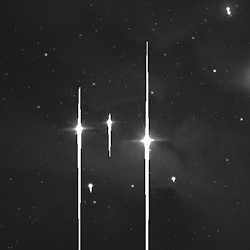Saturation is a normal part of CCD operation. Each pixel of the CCD can only contain so many electrons. The capacity of each pixel is referred to as "full well" capacity, which is usually several hundred thousand electrons. Once this capacity is exceeded these excess electrons must go somewhere. Usually they begin to pour over the potential barriers that define the pixel and into adjacent pixels. Because the barriers are lower in the parallel direction the spill is along the parallel register of the CCD, up and down in the image of most CCD cameras. Thus the familiar vertical blooming spikes as shown in the first example to the right.
In an antiblooming CCD there is a special drain to draw off these excess electrons before they spill into adjacent pixels, the cost is that this drain takes up room in the CCD structure, thus the CCD has less full well capacity and potentially lower quantum efficiency.

